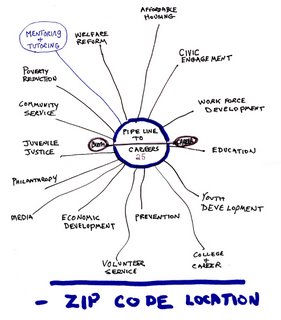For the past week the
Chicago Sun Times has been giving major media space to the way Illinois State Senator James Meeks, who is also pastor of Salem Missionary Baptist Church in the Roseland area of Chicago, delivered a message about the miserable condition of schools and education opportunities for kids living in highly segregated, high poverty neighborhoods. You can follow these stories at the
http://www.suntimes.com web site.
Since the minister blamed the Mayor, Richard Daley, for the condition of schools, the Mayor has been responding. Since the minister used the N-word, the media are also making this a front page issue.
I think the media, the minister and the mayor are missing an opportunity. The minister wants the mayor and the majority ethnic community, mainly White people, to do more to help improve schools in poor neighborhoods. More money to hire high quality teachers and improve facilities is the goal for the minister. The media and the mayor are responding to the way the minister delivered this message, using the N-word in his sermon last week.
All of this sells lots of papers for the
Chicago Sun Times, but does little to change the education opportunities for inner-city kids. No matter how correct the minister may be, nothing will change on the public funding level in the next four weeks. Maybe not in the next four years. Furthermore, if you read the information posted by the UCLA Center for Mental Health in Schools, just pouring more money into teacher pay and facilities is not going to change the outcomes for inner city kids because it does not change the availability of learning supports for kids in these schools.
None of these mega-leaders are talking about learning supports, or the long-term strategies that would lead to more people, or all races, creeds and color, becoming personally involved in efforts to help inner-city kids succeed in school and move to jobs and careers.
Just by putting more money in teachers and facilities won’t change the make-up of the communities where these kids live, which are high poverty, where many of the most prominent role models are adults who are working in illegal trades, have dropped out of school and/or are ex-convicts.
Just writing infrequent, but sensationalist, media stories, making speeches, and marching in the streets, won’t get more people personally involved in helping other people’s kids grow up. The minister, the mayor and the media need to be thinking of new ways to get business people (of all colors, and from the city and suburbs) personally engaged in the lives of economically-disadvantaged kids.
To me, that means they should be talking about volunteer-based tutoring/mentoring, and the places in poor neighborhoods where people who live in the suburbs, but work in the city, could be spending a couple of hours each week as a tutor/mentor instead of fighting the rush hour traffic. These are also places where people who live in the city and in these neighborhoods, could also be involved, as leaders and organizers of tutor/mentor programs.
They should also be talking about how churches, banks, and community health centers in high poverty neighborhoods, and along the routes city workers take in coming and going to work each day, could be hosts to tutor/mentor programs, creating more places where kids and volunteers can meet.
Finally, they should be thinking of ways to encourage people who go to church every Sunday might give 2 to 3% of their wealth each year to support these tutor/mentor programs. There just is a limit to how much public money is available. Non school programs need an infusion of private sector and corporate money. Who better to lead in the giving than people of faith?
If we expand the number of adults connected with kids, we immediately provide learning supports that can change the aspirations kids bring to school. And, we create a strategy that bridges the divides separating rich and poor, and people of different colors from each other. If we increase the number of people engaged in mentoring, and systematically educate them on what they can do to change public policy, we could have a different public funding system in place a few years down the road.
If we don’t think of how to expand the choir, we’ll just keep preaching to a small group of followers. That won’t do much to change the disadvantages that inner city kids face and it won’t make Chicago a better city for everyone to raise their kids.
I encourage the mayor, the minister, the media and the masses to visit the Tutor/Mentor Connection on the
http://www.tutormentorconnection web site. Here we all can meet, share information, learn about tutoring/mentoring programs, and find places where people can be a volunteer, a donor, or a leader.
There are still four weeks in August when media, mayors and ministers, as well as leaders from other industries can be encouraging employees, faith members and friends to get involved in tutor/mentor programs.
Through this involvement many will begin to take a personal interest in the things the minister and the mayor are talking about, and this can lead to the changes in public policy and public funding, that will lead to more systemic changes in how we help economically disadvantaged kids get lifelines out of poverty.






